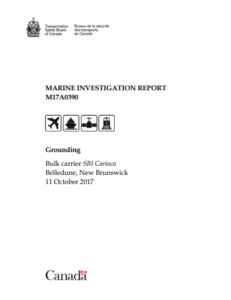The Transportation Safety Board of Canada (TSB) released its investigation report about the grounding of the bulk carrier SBI Carioca near the Port of Belledune in Chaleur Bay, New Brunswick, on October 2017.
The incident
On 05 October 2017, the SBI Carioca departed Newport News, Virginia, for Belledune, New Brunswick, with 65 962 metric tonnes of petroleum coke (petcoke) in the cargo holds and 22 crew members on board.
[smlsubform prepend=”GET THE SAFETY4SEA IN YOUR INBOX!” showname=false emailtxt=”” emailholder=”Enter your email address” showsubmit=true submittxt=”Submit” jsthanks=false thankyou=”Thank you for subscribing to our mailing list”]
At 0530, the master of the SBI Carioca contacted the master of the Atlantic Teak by VHF radiotelephone to discuss pilot boarding arrangements. Because the pilot boarding station was not marked on any charts, the master ordered that the SBI Carioca go to an area about 1.5 nm northeast of the pier.
When the Atlantic Teak reached the SBI Carioca, the crew on board the Atlantic Teak saw that the SBI Carioca’s pilot ladder was dragging in the water and requested that the crew of the SBI Carioca raise it. This delayed the pilot’s boarding of the vessel by about 4 minutes.
When the pilot arrived on the bridge, there was an exchange of vessel information between the master and the pilot. The pilot then called for hard to starboard; the vessel was too close to the pier and there was not enough time for it to safely make its approach.
By approximately 0702, the vessel had completed the apex of its manoeuvre, with the pilot’s priority was to slow the vessel down before making the turn for the approach to the northern pier.
The pilot ordered numerous and varied manoeuvres for the vessel and tugs in order to slow the vessel down and change its course toward the pier. The pilot was not monitoring the radars or ECDIS, and he issued helm orders without informing the other bridge team members his plans for an alternative approach to the pier.
At about 0720, the SBI Carioca ran aground. Shortly after, the pilot checked the radar for the first time, and realized the vessel was aground.
The SBI Carioca was refloated at the next high tide with the help of the Atlantic Teak and the Atlantic Spruce. No damage to the vessel or pollution was reported. No injuries were reported as well.
Probable cause
The investigation concluded that the absence of clear, published information about the position of the Port of Belledune’s pilot boarding station contributed to the vessel being closer to the pier than was practical for a safe approach.
Moreover, the pilot navigated the vessel using only visual references and did not request or receive feedback from the bridge team.
An ongoing exchange of information and teamwork, which are key principles of bridge resource management, are essential to help create a shared mental model necessary to safely navigate
What is more, if formal passage plans are not devised and shared among bridge team members, there is a danger that members will not be able to effectively monitor the vessel’s track and progress. This is why the Board has long recommended that Transport Canada require that pilotage authorities publish official passage plans to enable close and continuous monitoring by ship’s personnel. The Board has assessed the Atlantic Pilotage Authority’s response to Recommendation M94-34 as Unsatisfactory. The recommendation is still active.
Recommendations
A pilot boarding station symbol has been added to Canadian Hydrographic Services charts at 47°56′ N and 65°48′ W, approximately 2 nautical miles northeast of the Port of Belledune breakwater.
In addition, the Transportation Safety Board of Canada has sent marine safety advisories to the Canadian Department of Fisheries and Oceans and the United Kingdom Hydrographic Office to inform them of the addition of the pilot boarding station to the chart so that these organizations can update their sailing directions.
See more information in the PDF herebelow































































